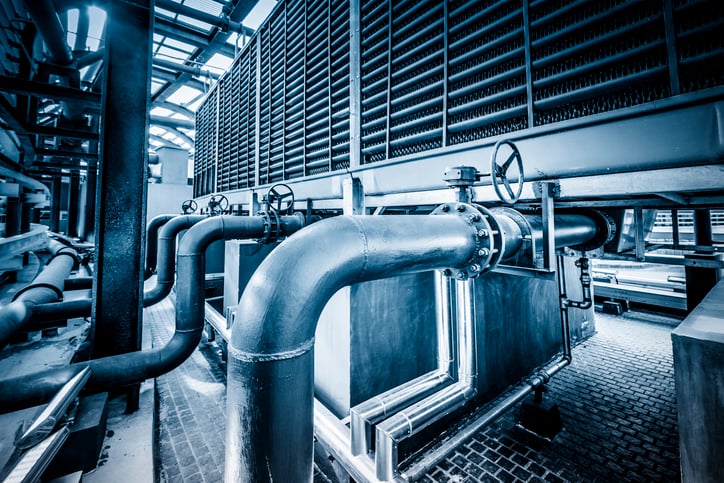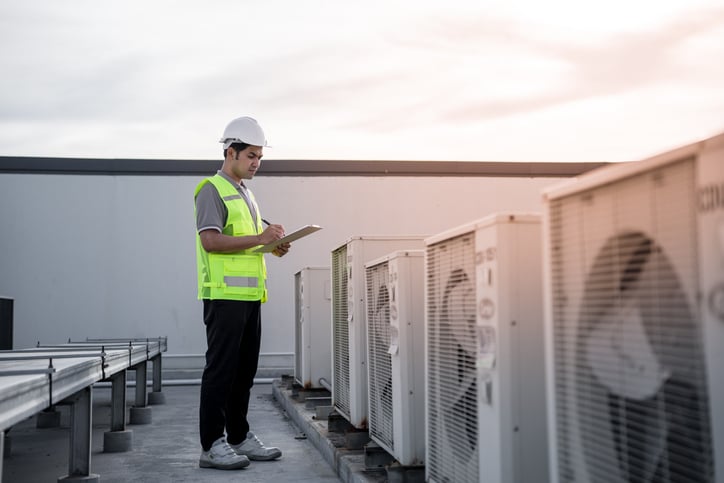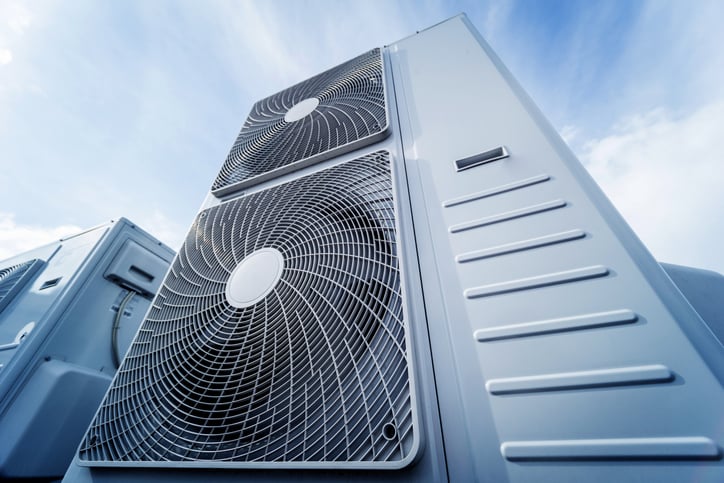HVAC Sensors | Upgrading System Efficiency & Comfort + Chart

The hottest day in the summer. The coldest day in the winter. Or any day in between.
Walk into a building of any sort with an HVAC system that's not functioning as expected and you'll know it – it's hard to miss going into a space that's too cold or too hot.
The same goes for when you get an energy bill that far exceeds what you anticipated – when your HVAC is not running efficiently, you'll feel it in your wallet.
Yet HVAC systems are also the unsung hero when conditions in a building are exactly how occupants want them – no one's ever seriously complained about being in a space that was too comfortable.
While a building's HVAC is often thought of as a large and singular unit, its smallest components – HVAC sensors –have the biggest impact on how the system runs.
In this article, we'll look at how advanced sensor technology – a necessary part of any HVAC system's design – helps a building's heating, ventilation, and air conditioning stay within performance specs for energy use without sacrificing comfort.
How Advanced Sensor Technology is Changing HVAC Systems
A workhorse of sorts for human comfort, HVAC systems have been keeping spaces at just the right temperature since the turn of the 20th century.
However, the systems you'll find now going in commercial and industrial buildings – and even homes – are a far cry from the first iterations of Willis Carrier's heating and cooling system. In fact, the HVAC systems of today can do more than their predecessors of even 20 years ago.
More sophisticated, more energy efficient, and more customizable, modern HVAC systems offer a level of performance that allows building owners to do more than heat up or cool off a room.
What's driven this transformation?
Advanced HVAC sensor technology.
Able to take accurate and repeatable measurements while providing real-time feedback, advanced sensor technology brings a great level of control and precision reactivity to HVAC systems.
With integrated advanced sensors, it's not only easier to control how long the HVAC system runs and in zones, but also to know when it needs to start, stop and run differently. With a wider range of sensors found in modern HVAC systems – both analog and digital – it's easier to set – or even automate – airflow, temperature, occupancy patterns, and even adjust humidity to fit building use.
Taking things a step further, advanced sensors are upgrading commercial and home HVAC system designs to improve health. Many of the same sensors already integrated into modern HVAC systems can also recognize and help mitigate indoor air quality issues – something that's become increasingly important in an almost post-COVID world.
This evolution in indoor climate control should come as no surprise. In certain respects, HVAC systems are getting the same treatment vehicles rolling off production lines or your wristwatch that counts steps and monitors your heart rate. With advanced sensor technology, HVAC systems have become "smart" and do more – especially when it comes to reducing energy consumption and meeting a variety of metrics for comfort.
4 Advanced Types Sensors Enhancing HVAC System Functionality, Performance + Chart
In a certain respect, modern HVAC systems are like the vehicles rolling off assembly lines these days. While they're indeed technological marvels, what makes them function at peak performance is the data and monitoring provided by sensor technology. And for practically every metric in a vehicle, there's a type of sensor to monitor it.
Just like new cars and trucks, there's a wide variety of sensors that can be integrated into an HVAC system to regulate performance and monitor other parameters of function, there are four types of sensors that are absolute musts:
-
Temperature Sensors in HVAC systems are fundamental for ensuring consistent climate conditions. Unlike traditional systems that operate on a rigid schedule or simply rely on thermostats, modern HVAC temperature sensors enable a more reactive approach, only activating heating or cooling when necessary. By accurately assessing the room temperature, they control the HVAC components like the compressor and evaporator, preventing excessive running.
Additionally, they facilitate zone balancing, where different areas of a building can be heated or cooled based on individual requirements, avoiding wasteful energy use.
-
Pressure Sensors maintain the balance between internal and external air pressures, crucial for air quality and moisture management. An airflow sensor of sorts within the system, differential pressure sensors check the condition of filters and detect any pressure discrepancies.
By maintaining a positive pressure, they create exfiltration and prevent infiltration, both of which are vital for energy efficiency and indoor air quality (more on that later). Proper pressure management ensures that the HVAC system distributes air evenly and efficiently.
-
Humidity Sensors in HVAC systems manage moisture levels, which is critical for both comfort and health. High humidity can lead to microbial growth, while low humidity can cause dry skin and respiratory issues. Measuring the relative humidity (Rh) in a space, these sensors allow the system to keep airborne water vapor levels within an appropriate range.
Moreover, managing humidity is energy-efficient since air with higher vapor content requires more energy for temperature regulation due to its greater mass and enthalpy (total heat content). Ideally, most spaces should have a humidity between 40-60% – that range is relative to the space and its use. For instance, a greenhouse will be purposely more humid than say an antique store.
-
Indoor Air Quality (IAQ) Sensors have seen a new level of importance in the wake of heightened awareness around health issues since the COVID-19 pandemic. Now an almost requirement in HVAC system design, IAQ sensors are used to detect pollutants like particulate matter, VOCs, and CO2, offering real-time data for immediate system adjustments. What's more, by keeping positive pressure inside a building, they can prevent – to a degree – pathogens from entering. This enhanced level of system monitoring reduces health risks associated with poor air quality, such as respiratory issues and allergic reactions. In health-critical situations, like a pandemic, these systems are vital in controlling the spread of airborne diseases by ensuring a steady flow of clean air.
Beyond individual health benefits, these air quality HVAC sensors are increasingly integrated into broader building management systems (BMS). This integration allows for a holistic approach to indoor environment management, combining air quality data with other parameters like temperature and humidity. It enables facility managers to comprehensively control the indoor climate, track long-term trends, identify potential issues proactively, and make informed decisions regarding building maintenance and operations.
Sensor Type |
Efficiency Function |
Comfort Function |
|
Temperature |
Activates heating or cooling only when necessary, avoiding excessive energy use. Controls HVAC components to prevent unnecessary running. Facilitates zone balancing for efficient energy use. |
Ensures consistent climate conditions by heating or cooling based on real-time temperature data. Provides for tailored comfort in different areas of a building. |
|
|
Monitors and maintains optimal airflow, reducing strain on system components. Ensures even distribution of air, enhancing system efficiency. |
Maintains balance between internal and external air pressures, improving air quality and moisture management. Helps in preventing air leaks for better indoor climate. |
|
|
Adjusts system operation based on moisture levels, which is energy efficient as air with higher vapor content requires more energy to regulate temperature. |
Manages indoor moisture levels to prevent issues like mold growth or dry skin. |
|
|
Encompassing a wide variety of sensors, including airflow and CO2 sensors for HVAC, this type actively evaluates air quality data, which can improve energy use over time. |
Continuously adjusts to maintain healthy indoor air, addressing concerns like CO2 levels, VOCs, particulates, and humidity. |
Beyond Comfort, In Sync With Efficiency
Improved energy efficiency and enhanced comfort management are only two parts of the story for pairing HVAC systems with advanced sensor technology. With integrated advanced sensors, building managers can do more to maintain or extend the useful lives of their heating and cooling systems. Integrated advanced sensors allow for:
-
Predictive Maintenance and Fault Detection: While continuously monitoring system performance, advanced sensors can predict potential issues before they escalate into major faults. This proactive approach saves time and resources, significantly reducing downtime and maintenance costs. By detecting minor issues like leaks, blockages, or mechanical wear early, sensors prevent extensive damage and extend the lifespan of HVAC equipment.
-
Remote Monitoring and Control: The modern world demands convenience and control for major appliances and equipment – most new cars these days can be started from your phone anywhere in the world. The same goes for HVAC systems. With remote monitoring and control capabilities, users can manage their HVAC systems from any location, using smartphones or computers. This flexibility is invaluable for maintaining optimal indoor climates, even when the occupant is away, ensuring energy is not wasted heating or cooling unoccupied spaces.
-
Integration with Other Smart Home Systems: HVAC systems with advanced sensor technology are increasingly becoming part of a larger ecosystem of smart home devices. This integration enables a cohesive operation with other systems, such as lighting, security, and entertainment. For instance, an HVAC system can adjust the temperature based on occupancy sensors used for security, or align with smart blinds to utilize natural heating or cooling.
Advanced Sensors: Heating, Ventilation, & Cooling 2.0
As buildings, homes, and other spaces continue to get smarter with the technology and utilities installed in them, the role of advanced HVAC sensors cannot be overstated. These systems are now more than just facilitators of comfortable indoor climates. With the integration of advanced sensors, HVAC systems have become critical tools in energy management, health protection, and predictive maintenance.
Upgrade Your HVAC System
Speak with one of our advanced sensor technology experts today:




